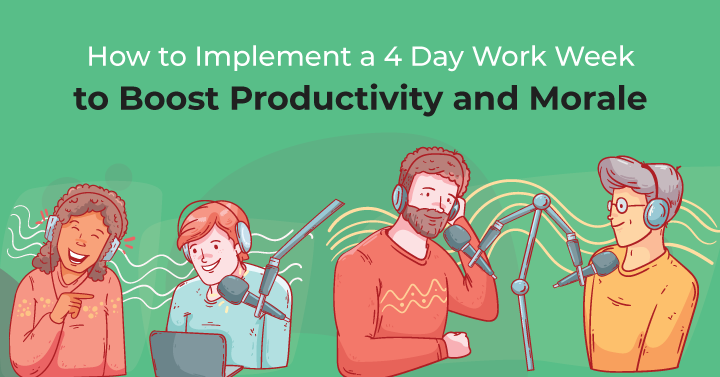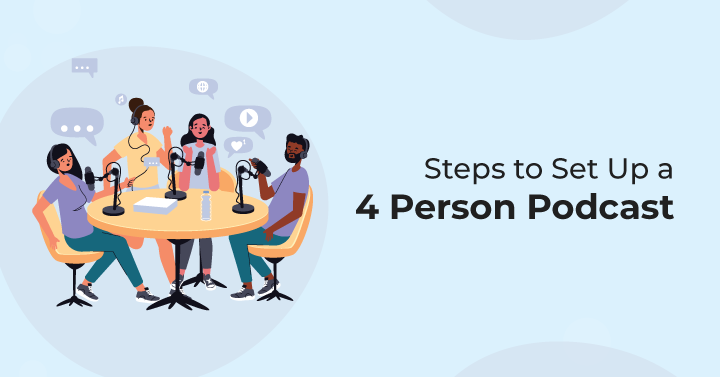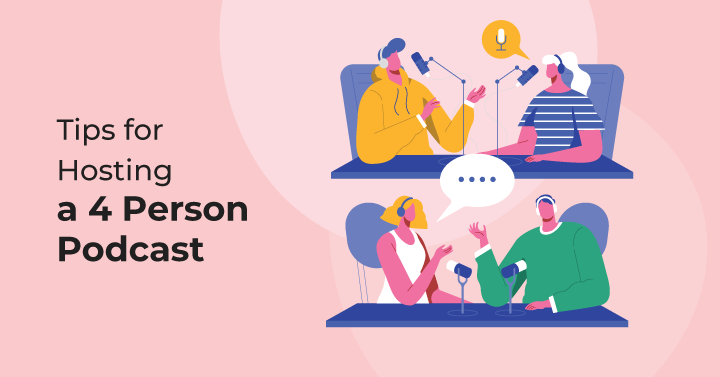
Even if you are an experienced solo podcaster, running a 4 person podcast setup can present a number of unique challenges. Adding more participants into the mix means more audio feeds to manage as well as more logistical factors to consider in terms of setting up and running a recording session. Of course, the upside is that having more people involved can lead to an engrossing discussion with diverse perspectives.
To help you get started, we’ll take you through some of the common issues involved in putting together a 4 person podcast, as well as the kind of equipment you’ll need and the steps you should take to ensure a smooth recording.
1. Importance of Setting Up a 4 Person Podcast
Good planning can alleviate most, if not all, of the challenges associated with a 4 person podcast setup. Aside from the increase in equipment costs, you should expect a lot more to manage in terms of coordinating people, adjusting sound and preparing your episode content.
The benefits of making these arrangements are manifold. A show with 4 participants is likely to be more engaging and dynamic for listeners. If you choose the guests wisely, you’ll be able to feature a greater diversity of perspectives on any given topic, enriching your show. It’s also worth noting that your guests may have different networks of followers, which will allow you to reach new audiences.
2. Choosing the Right Equipment for a 4 Person Podcast
2.1 Microphones
Microphones are one of the most important piece of equipment for a 4 person podcast setup. You want to ensure you capture amazing sound quality during recording so you don’t have to spend too much time on the editing process.
For a piece of equipment that unites quality with ease of use and a reasonable price point, the Blue Yeti is a top-notch option. Costing $129.99 per unit, the condenser mic allows you to select your own polar pattern (cardioid is ideal for a 4 person podcast setup). Another money-saving aspect is the USB output, which lets you plug directly into your laptop without the need for an audio interface.
2.2 Headphones
It’s important for each participant in a podcast to be able to hear themselves as well as everybody else clearly, without external distractions. A good pair of over-the-ear headphones will let them do just that, isolating voices from background noises. For the host, if the headphones are plugged into a mixer, they can live tweak the sound using a mixer, which can decrease the need for editing post-recording.
The Sony MDR-7506 might not be the most stylish option out there, but the sound quality is excellent and they only cost $88 per pair. These should definitely be in contention if you want professional-level quality from a big-name brand and don’t need lots of fancy embellishments.
2.3 Mixer
Mixers are arguably more important for a 4 person podcast setup than other arrangements because you have to stay on top of multiple tracks. With a mixer, you can use dials or sliders to control the sound for each individual person, adjusting things like gain and adding in special effects on the fly.
Priced at $219, the Zoom PodTrak P4 has been designed specifically as a podcast mixer 4-person device. It features 4 mic inputs with XLR connectors alongside 4 headphone outputs, all somehow crammed onto a portable, handheld device. Each input has its own gain control knobs, mute buttons and phantom power switches. Plus, there are 4 sound pads that can be assigned sound effects from a preset selection of 11.
2.4 Camera
Adding a video element to your podcast is one way to increase your audience. Not only does it mean you can access users of YouTube, but you can then also create short teaser clips that can be shared on social media channels like TikTok and Instagram. Video podcasting has become increasingly popular in recent years, as people feel there is a greater sense of connection and authenticity when they can see podcasters perform.
Your video podcast setup can include one camera per participant, a single camera for everyone or something in between. Most video podcast viewers don’t expect to see visual fireworks, so you won’t need to invest heavily in your camera equipment. The Canon PowerShot SX740 ($399.99) is a good-enough entry-level device if you want a cheap 4 person podcast setup. The device supports 4K video at 30 frames per second or 1080p at 60 frames per second. It also has Wi-Fi and Bluetooth connectivity to facilitate file sharing.
3. Steps to Set Up a 4 Person Podcast

3.1 Define your podcast’s topic and format
The first step when setting up any podcast is to define what it is about and how you’re going to conduct it. Will it be recorded in person in a recording studio or over a video communications platform? Is it a political panel discussion or a conversational show about pop culture? Since a 4 person podcast setup tends to involve more work, you need to justify why your show needs to have a quartet of speakers.
3.2 Choose a quiet recording location
The less ambient noise in your recording location, the better sound quality you can achieve. Starting off without lots of background hums and hisses means you won’t have to do as much editing to create a top-notch listening experience.
3.3 Test your equipment
Get experimental with your equipment arrangement. Are the mics far enough apart to avoid feedback? Will the video cameras capture all the participants properly? Doing these simple checks beforehand will save you future tribulations.
3.4 Develop a recording schedule
On a macro level, plot out your long-term editorial calendar in terms of episode topic and when you want new episodes to drop. On a micro level, create a schedule that includes details of how long you expect to spend conducting research, finding and confirming guests, writing a script, recording the episode and editing the episode.
3.5 Invite your guests
Your 4 person podcast might be a little lonely without guests! Once you’ve confirmed the speakers, don’t forget to drop them an email stating the time, place and outline of the episode recording. If you are recording remotely, send out the meeting link beforehand with clear instructions on how to access your chosen platform.
3.6 Record your podcast
Now you’ve got all the planning stuff nailed, it’s time to actually record your podcast! Assuming you’ve properly organized the prep, all you need to worry about now is keeping track of the sound live and shepherding your participants.
3.7 Edit your podcast
After the recording is out of the way, you will have the opportunity to tidy up the sound, combine the separate audio tracks and add in any sound effects. For video podcasts, you may also want to include some graphics or short clips.
3.8 Publish and promote your podcast
The final stage is to publish your podcast and share it with the world. This process can be simplified by utilizing a podcast hosting platform that will automatically share new episodes to popular platforms like Apple Podcasts and Spotify. You can also promote your new episodes using social media.
4. Challenges of 4 Person Podcast Setup
4.1 Audio quality
A 4 person podcast setup means four times as many audio feeds to worry about. One of the main challenges is to ensure each speaker is only getting picked up on their own microphone, and not another participant’s microphone as well. Additionally, the pitch and volume of each person will vary, which will require you to make some adjustments to even out the sound.
4.2 Scheduling conflicts
Getting 4 people to meet in the same place at the same time is a pretty big challenge, especially if 3 of those 4 people are guests. One of the ways you can alleviate this issue is by hosting your podcast over Zoom or another common video communications platform. Of course, this approach comes with its own headaches, such as the differing quality of your participants’ microphones, headphones and cameras.
4.3 Time management
Managing time adequately is a challenge all podcasters face, but there is an added burden for a 4 person podcast setup due to factors like scheduling requirements and post-production editing. Having a consistent program of podcast episodes is a core part of building up a sustained audience, which is why it’s so important to ensure you don’t have to delay releases due to inefficient time management.
4.4 Lack of coordination
There are two main ways to tidy up audio: using a mixer during the recording session and/or using a digital audio workstation after the recording has been completed. The challenge with the former is trying to keep track of four different voices on the fly. If you don’t have someone to assist you with coordinating the sound, you will have to simultaneously make audio adjustments while at the same time staying on top of the conversation.
4.5 Time-consuming editing process
Editing 4 tracks into 1 finished product is, obviously, more time consuming than trying to edit a single track alone. If there are more complex sound issues that can’t be corrected using a mixer live, you’ll need to spend longer making tweaks in post-production.
5. Tips for Hosting a 4 Person Podcast

5.1 Choose your guests wisely
This sounds like a super obvious piece of advice, but having the right balance of guests will determine how good the finished episode is. To some extent, the quality of the show is decided before you even begin recording.
5.2 Assign roles
Are you going to be in charge of everything, from planning and scriptwriting to hosting and editing? Or will you have somebody else handling some aspects of the podcast production? If you are co-hosting with a friend, make sure you each have defined roles to avoid confusion.
5.3 Set a clear agenda
Giving everybody a framework to build off means the participants have some idea of what to expect and can prepare accordingly. It also allows the host(s) to ensure everybody gets their say. It’s very easy for someone to begin rambling or to (intentionally or unintentionally) take over the conversation. By having a clear agenda, you can feel comfortable bringing the discussion back to your key talking points.
5.4 Encourage participation
Some people require more of a nudge than others to speak up. Simple prompts like, ‘What do you think about that, Mr XYZ?’ help smoothly bring people into the discussion. Try and give everybody the same amount of time to talk, even if that requires a greater amount of prodding directed at the more reticent participants.
5.5 Keep it conversational
Podcasts with more than 1 or 2 participants are generally about generating discussion, rather than recapping the news or delivering education. That’s why for most 4 person podcast setups, you’ll probably want to aim for a conversational tone. That doesn’t mean there can’t be disagreements, but having guests talking over one another really doesn’t lend itself well to the podcast format.
5.6 Edit carefully
For a lot of podcasters, editing is the most boring part of making a show. The process can be full of time-absorbing touch-ups to enhance the sound, but it is worth the effort to end up with a professional finished product.
6. FAQs
- What is needed for a 4 person podcast?
A 4 person podcast setup for beginners should include 4 mics, 4 headphones, a simple mixer and some kind of computer to store and edit the recordings. If you’re filming a video podcast, you’ll also want to invest in some basic camera device(s).
- Can a podcast have 4 people?
Yes, you can have a podcast setup for 3, 4, 5 – you can even have a 6 person podcast setup. Just bear in mind that there are added complexities and expenses associated with having a greater number of people involved in a podcast recording.
- How do I record a podcast with 4 people?
Make sure you test the equipment arrangement and set a clear agenda beforehand. This kind of prep will make it a lot easier to run a seamless recording session.
- What do I need for a multi person podcast?
Usually, a multi person podcast requires at least 1 mic and 1 headphone per participant. You should also consider incorporating a mixer to separately manage each audio input.



